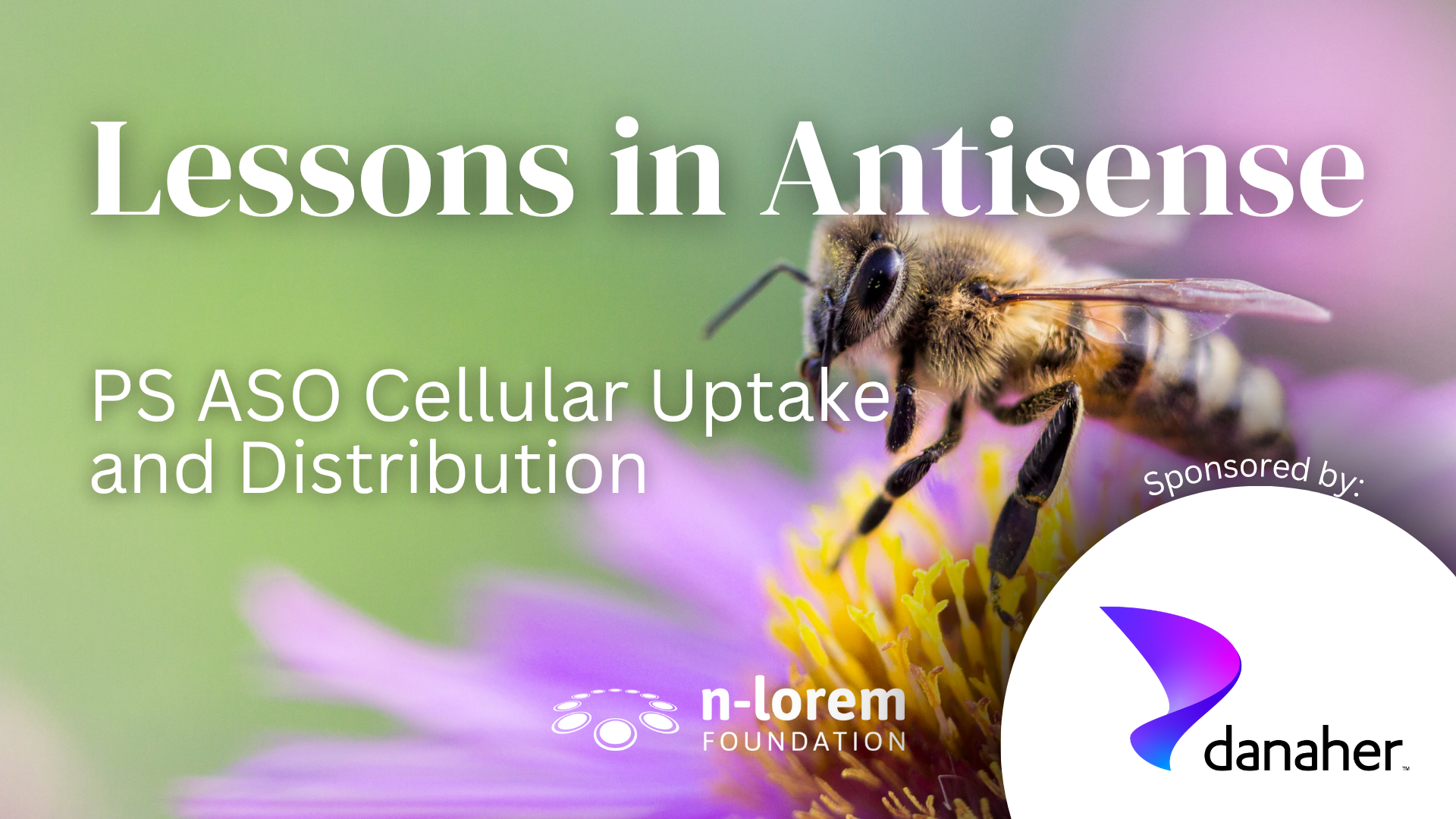Lessons in Antisense
Lesson 14 – PS ASO Cellular Uptake and Distribution
July 21, 2025 by Dr. Stan Crooke

Introduction
Just as phosphorothioate (PS) moieties define the distribution and clearance properties of PS, PS moieties drive cellular pharmacokinetics. The basic rule is that if a PS ASO is located in a biological site, a protein or proteins are responsible for it being there. In contrast, the 2’-modification selected, e.g. 2’-MOE, 2’-cEt, or LNA seem to have very limited effects on distribution. To date, these general principles apply to all types of cells studied from all species studied.
We define “productive cellular uptake” as uptake that results in PS ASO entering cells in a fashion that leads to pharmacological effects and there are cell lines that simply do not productively take up PS ASOs. During substantial efforts to understand the differences in cellular architecture and protein composition between cells that engage in productive PS ASO uptake and those that do not, I failed to identify reproducible differences. However, it is clear that the ability to productively internalize PS ASO can be rapidly lost as cells are passaged.
The fact that not all cells in a cell population display internalized PS ASOs and the observation that different cells take up varying amounts of PS ASO are sources of variability that can confound experiments. One way to control this variability, at least in part, is to include cell uptake controls using either a fluorescently labeled PS ASO or an ASO targeting a known target such as NEAT1 as controls.
Adsorption of PS ASOs to exposed cell surface proteins
The first step in cell uptake is simple adsorption to the extracellular domains of membrane-localized proteins. This is non-energy dependent, not temperature dependent, but PS ASO and cell concentration dependent. This step is extremely rapid. We have only identified a tiny fraction of the proteins at the plasma membrane localized proteins that bind to PS ASOs. Those associated with “productive uptake” include stabling, epidermal growth factor receptor (EGFR), scavenger receptor B (SRB), and G-protein coupled receptor (GPCR). We also know that PS ASOs can bind to asialoglycoprotein receptors (ASGPR), but we see ASGPR play a role in productive cellular uptake only when we conjugate a targeting ligand, GalNAc. There are also a few proteins such as TLRs and integrins that bind PS ASOs non-productively. Bottom line, we think that PS ASOs adsorb indiscriminately to cell proteins, most of which do not contribute productive cellular uptake.
Though we have shown that membrane lipid composition can influence cell uptake of PS ASOs, we have not identified any direct interactions of PS ASOs with lipids in membranes. If a lipophilic conjugate is such a long-chain fat, we increase the amount of PS ASO that is trapped in membranes.
Sulfhydryl Exchange
PS ASOs can behave like sulfhydryl’s, i.e. they can be oxidized and reduced and can form disulfide–like bonds with cysteines. This led me to propose many years ago that one means of cell uptake might be sulfhydryl exchange. In this mechanism, PS ASOs simply form transient disulfides with membrane proteins, and eventually with cytoplasmic proteins. This has recently been shown to happen, but I think this mechanism accounts for very little productive uptake. An open question that remains, however, is there medicinal chemical approaches that could enhance sulfhydryl exchange.
Endosomal uptake and release
The decision as to whether or not productive uptake of PS ASOs occurs is made on the cell surface and depends on the membrane proteins to which PS ASOs bind. The major nonproductive uptake process is micro-pinocytosis, but the first productive step is the accumulation of PS ASOs into early endosomes (EE). The next step is accumulation of PS ASOs into late endosomes (LE). This step is dependent on Annexin A2 (ANXA2) even though PS ASOs do not bind to ANXA2. In LEs, PS ASOs accumulate in intraluminal vesicles. TCP1 is a critical protein in this process and PS ASOs bind to this protein. PS ASO-laden LEs interact with the Golgi apparatus in both forward and reverse pathways, and key proteins include M6PR, GCC2 and LBPA. In the presence of PS ASOs, PS ASO-laden LEs also fuse with COP2 vesicles, and this appears to be mediated by a single protein, STX5. In LEs, PS ASOs migrate toward the microtubule organizing center (MTOC) near the nucleus. Though release can occur during interactions with the Golgi or during fusion of COP2 vesicles, the bulk of the release occurs near occurs near the MTOC.
Several mechanisms of release have been identified. Blebbing appears to be quite important, but membrane flipping and vesicular leaking are also involved. The entire process of EE uptake, transfer to LEs, migration along microtubules and release is quite slow. Accumulation into EEs is observed at about 10-20 minutes, LE accumulation is observed in 60-120 minutes, and we typically begin to see very limited ASO activity at 4-8 hours, with maximum activity observed around 16 hours.
PS ASOs begin to accumulate in lysosomes at about 60 minutes, and entry into lysosomes is mediated by a single protein, SID1 transmembrane family, member 2 (Sidt2). Once in lysosomes, PS ASOs are inactive and eventually metabolized by nucleases. If Sidt2 is reduced, entry of PS ASOs into lysosomes is delayed and reduced, enhancing and prolonging PS ASO activity.
Effects of targeting ligands
The most thoroughly studied ligand is GalNAc targeting the ASGR. Though we can detect no measurable shift in the amount of PS ASO bound to ASHR at the membrane, we consistently observe a 20–30-fold increase in potency, demonstrating both how limited productive uptake is and the value of increasing the fraction taken up by productive endosomal processes. The GalNAc is removed from the PS ASO during the invagination process.
Opportunities
We estimate that >95% of PS ASOs in the cell are inactive. Consequently, if we could use medicinal chemistry to shift binding to desired intracellular proteins and/or reduce uptake into lysosomes, we could significantly enhance potency and duration of effect.
Conclusions
We now have a reasonably detailed understanding of how PS ASOs enter and distribute in cells. We know that the major pathway is endosomal uptake. We know the key proteins and the key steps involved, and we have a solid understanding of the kinetics. The challenge now is to use the information we have to design improved PS ASOs. Since we estimate that >90% of PS ASO in cells is not available to the target RNA, the next steps are to better understand the binding preferences of key proteins for PS ASO characteristics and design PS ASOs that have reduced binding to proteins, such as Sidt2 , that reduce PS ASO activities and enhance binding to proteins that play a key role at the cell surface and throughout the endosomal processes to deliver PS ASOs to sites of action in the cell.

We cannot do
this alone
Together we are changing the world—
one patient at a time
We hope that you join us on this journey to discover, develop and provide individualized antisense medicines for free for life for nano-rare patients. The ultimate personalized medicine approach – for free, for life.
Follow us on social for updates on our latest efforts


